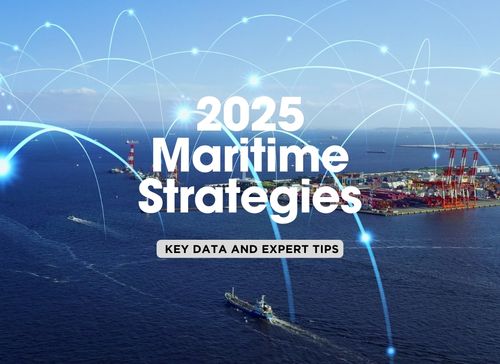Maritime Economic Outlook in 2025: Key Data and Insider Tips to Tackle Freight Rates, Fuel Costs, and Economic Shifts

As we look toward 2025, the maritime shipping industry faces a myriad of economic forces that will shape freight rates and overall market conditions. From global economic trends to fluctuating fuel costs and geopolitical tensions, there are numerous factors creating both challenges and opportunities for ship owners and operators. Understanding these variables can offer invaluable insights for making strategic decisions in the coming year.
Global Economic Conditions and Their Impact on Freight Rates
As economies worldwide continue to recover and adapt post-pandemic, we’re witnessing varied impacts across regions. Economic growth, inflation rates, and consumer spending patterns will play significant roles in determining freight demand and, consequently, shipping rates in 2025. By examining specific regions and key indicators, we can anticipate how these economic conditions might influence freight rates on major shipping lanes, giving ship owners a clearer picture of the landscape.
| ShipUniverse: Comparing Freight Rates by Region Amid Economic Conditions | ||||
|---|---|---|---|---|
| Region | GDP Growth Rate (2024) | Inflation Rate (2024) | Average Freight Rate (2024) | Projected Freight Rate (2025) |
| North America | 2.6% | 3.4% | $1,200 per TEU | $1,250 per TEU |
| Europe | 0.7% | 5.0% | $1,500 per TEU | $1,550 per TEU |
| Asia-Pacific | 4.4% | 3.2% | $1,000 per TEU | $1,100 per TEU |
| Middle East | 3.0% | 4.8% | $1,100 per TEU | $1,150 per TEU |
| South America | 2.7% | 6.0% | $1,300 per TEU | $1,350 per TEU |
Supply and Demand Fluctuations in Maritime Shipping
Supply and demand imbalances continue to be a significant driver of freight rate volatility in maritime shipping. As we head into 2025, demand for shipping on certain high-traffic routes could fluctuate due to shifts in global production and consumer demand patterns. At the same time, supply levels—determined by fleet capacity and port infrastructure—will impact rates. Monitoring these fluctuations helps maritime operators and ship owners predict cost trends and better manage their shipping budgets.
| ShipUniverse: Monthly Supply and Demand Trends for Key Shipping Routes | |||||
|---|---|---|---|---|---|
| Month | Major Route | Demand Index (2024) | Supply Index (2024) | Spot Rate Change (%) | Capacity Utilization (%) |
| January | Transpacific Eastbound | 100 | 95 | +5% | 90% |
| February | Asia-Europe Westbound | 90 | 100 | -2% | 85% |
| March | Intra-Asia | 105 | 100 | +3% | 92% |
| April | Asia-Middle East | 110 | 105 | +4% | 95% |
| May | Asia-North America West Coast | 95 | 100 | -1% | 88% |
Impact of Fuel Prices on Freight Rates
Fuel prices are a significant cost factor for shipping companies, often comprising up to 50% of total operating expenses. With the global push towards greener fuels and the fluctuating costs of marine fuels, the impact on freight rates is becoming more pronounced. As we approach 2025, understanding how changes in fuel prices translate into freight costs can help fleet operators manage budgets effectively and plan fuel-efficient routes.
| ShipUniverse: Fuel Price Variations and Their Effect on Freight Costs | ||||
|---|---|---|---|---|
| Fuel Type | Average Price per Metric Ton (2024) | Projected Price per Metric Ton (2025) | Freight Rate Impact (% Change) | Example Route Cost (per TEU) |
| Marine Gas Oil (MGO) | $850 | $880 | +3.5% | $1,300 (Transpacific) |
| Very Low Sulfur Fuel Oil (VLSFO) | $700 | $730 | +4.3% | $1,200 (Asia-Europe) |
| Heavy Fuel Oil (HFO) | $500 | $520 | +4.0% | $1,100 (Intra-Asia) |
| Biofuels (B100) | $1,200 | $1,150 | -4.2% | $1,400 (Asia-Middle East) |
| Liquefied Natural Gas (LNG) | $600 | $620 | +3.3% | $1,250 (Europe-North America) |
Freight Rate Volatility Due to Geopolitical Events
Geopolitical events such as trade wars, sanctions, and regional conflicts often lead to significant disruptions in shipping routes, impacting freight rates and overall shipping costs. As we move toward 2025, the maritime industry remains exposed to the effects of these geopolitical tensions. For ship operators, understanding these impacts on specific routes can provide a basis for risk assessment and contingency planning.
| ShipUniverse: Geopolitical Events and Freight Rate Impact in Key Shipping Lanes | |||||
|---|---|---|---|---|---|
| Geopolitical Event | Region Affected | Duration of Impact | Route Impacted | Freight Rate Change (%) | Additional Cost per Container ($) |
| Russia-Ukraine Conflict | Black Sea, Europe | Ongoing | Asia-Europe | +20% | $500 |
| US-China Trade Tensions | Asia-Pacific, North America | Intermittent | Transpacific | +10% | $400 |
| Suez Canal Blockage (2021) | Middle East | 6 days | Asia-Europe | +5% (short-term) | $300 |
| Houthi Attacks in Red Sea | Red Sea, Arabian Peninsula | Intermittent | Europe-Asia | +15% | $450 |
| Sanctions on Iran | Middle East | Ongoing | Asia-Middle East | +12% | $400 |
Inflation and Currency Exchange Rates Affecting Shipping Costs
Inflation and currency fluctuations can have a profound impact on international shipping costs. As inflation varies by country and currencies fluctuate, the cost of shipping on specific routes can change accordingly. For maritime operators, tracking these economic indicators is essential to understanding potential cost variations and planning budgets effectively.
| ShipUniverse: Exchange Rates and Inflation Impact on Freight Costs by Major Currencies | ||||
|---|---|---|---|---|
| Currency | Exchange Rate vs. USD (2024) | Projected Exchange Rate vs. USD (2025) | Inflation Rate (2024) | Impact on Shipping Cost per TEU ($) |
| USD | 1.00 | 1.00 | 3.2% | $1,200 (Transpacific) |
| EUR | 1.10 | 1.12 | 2.4% | $1,300 (Asia-Europe) |
| JPY | 0.007 | 0.0068 | 2.9% | $1,250 (Intra-Asia) |
| CNY | 0.14 | 0.13 | 2.5% | $1,100 (Asia-North America) |
| GBP | 1.25 | 1.24 | 5.1% | $1,350 (Europe-North America) |
Insider Tips for Navigating Freight Rate Volatility and Economic Challenges in 2025
As the maritime industry heads into 2025, staying agile and proactive in the face of economic changes is crucial for maintaining profitability. Here are some unique insider tips to help ship operators and owners adapt to evolving freight rate dynamics, fuel price shifts, and economic volatility.
1. 📉 Hedge Against Fuel Price Fluctuations
- Why it works: Fuel is a significant cost factor in shipping, and with fluctuating prices, budgeting can be challenging.
- Tip: Consider partnering with fuel suppliers or financial institutions to establish fuel hedging contracts. These contracts lock in fuel prices, minimizing the risk of unexpected cost spikes.
- Helpful Fields:
- Contract Type: Fixed or floating rate
- Term Length: 6-12 months
- Potential Savings: Up to 15% on fuel costs
2. 🌎 Diversify Currency Accounts to Offset Exchange Rate Risk
- Why it works: Currency fluctuations can impact profit margins, especially on international routes.
- Tip: Open currency-specific bank accounts in countries where your key routes operate. For example, if you frequently run routes in Asia and Europe, keep separate accounts in euros and yen to manage transactions in those currencies without conversion losses.
- Helpful Fields:
- Primary Currencies: USD, EUR, JPY
- Account Benefits: Reduced foreign exchange fees, potential for lower transaction costs
- Exchange Rate Savings: 2-5% per transaction
3. 🔍 Analyze Seasonal Route Demand for Strategic Scheduling
- Why it works: Shipping demand varies seasonally, and adjusting schedules can optimize load factors.
- Tip: Use historical data and predictive analytics to identify peak seasons for each route and align your schedules accordingly. For instance, optimize Transpacific routes in early Q4 for holiday season demand and Europe-Asia routes in early Q1.
- Helpful Fields:
- Tools to Use: Predictive analytics software (e.g., S&P Global Market Intelligence)
- Cost Impact: Adjusting schedules can reduce operational costs by up to 10%
- Peak Periods to Watch: Q4 for Transpacific; Q1 for Europe-Asia
4. 🚢 Leverage Empty Backhaul to Offset Costs
- Why it works: Many ships return with low cargo loads, leading to missed revenue opportunities.
- Tip: Collaborate with partners to secure backhaul cargo at reduced rates. For example, Asia-North America routes often return with empty containers, so establishing partnerships can help you reduce costs on these trips.
- Helpful Fields:
- Backhaul Savings: 20-40% on operational costs
- Top Routes for Backhaul: Asia-North America, Europe-Middle East
- Potential Partners: E-commerce companies, raw materials exporters
5. 📦 Consider Multimodal Solutions to Reduce Costs on Complex Route
- Why it works: Not all cargo needs to stay on a single vessel throughout its journey. Using rail or trucking for parts of the route can reduce costs and increase flexibility.
- Tip: For cargo going from Asia to inland destinations in Europe or North America, combine sea and rail or trucking where feasible. This approach often reduces costs and transit times.
- Helpful Fields:
- Cost Savings: Up to 25% for inland freight
- Top Routes for Multimodal: Asia-Europe, Asia-US Midwest
- Primary Modes: Sea-to-rail, sea-to-truck
6. ⚙️ Invest in Predictive Maintenance to Avoid Downtime
- Why it works: Unplanned maintenance can be costly and cause shipping delays, impacting overall profitability.
- Tip: Implement predictive maintenance technologies that use IoT sensors and AI to monitor vessel health. By catching issues early, you can avoid unexpected breakdowns and reduce repair costs.
- Helpful Fields:
- Potential Savings: Up to 20% in maintenance costs
- Recommended Tools: Condition-based monitoring systems
- Key Components to Monitor: Engines, fuel systems, hull
7. 💹 Negotiate Volume Discounts with Carriers and Ports
- Why it works: Increased cargo volume can provide leverage to negotiate lower rates, which is especially valuable on high-traffic routes.
- Tip: Work with carriers and port authorities to set up volume-based discount contracts. This approach can be particularly effective for companies with consistent shipment volumes.
- Helpful Fields:
- Typical Discount Range: 5-15%
- Top Routes for Savings: Transpacific, Europe-Middle East
- Negotiation Period: Early Q1 for best results
8. 🌐 Adopt Digital Freight Platforms for Real-Time Rate Comparison
- Why it works: Freight rates can fluctuate rapidly, and real-time comparison platforms help find the best deals.
- Tip: Use digital freight marketplaces that allow rate comparison across carriers. Platforms like Flexport and Freightos help you find the most competitive rates and secure bookings more efficiently.
- Helpful Fields:
- Cost Reduction Potential: Up to 10% on standard freight rates
- Platform Features: Rate comparison, booking management
- Best Times to Use: High-demand seasons, holidays
9. 📈 Utilize Freight Rate Forecasting to Plan Budget
- Why it works: Freight rates can be unpredictable, and forecasting allows for better budget planning.
- Tip: Leverage forecasting tools that use data from past rate trends and economic indicators to project future freight rates. This insight helps you time contracts and manage cash flow more effectively.
- Helpful Fields:
- Tools to Use: FreightWaves SONAR, Xeneta
- Cost Prediction Accuracy: Within 5% for most major routes
- Ideal Planning Window: 6-12 months in advance
10. 📊 Incorporate Carbon Offset Programs to Meet Regulations
- Why it works: With rising environmental regulations, shipping companies are increasingly expected to reduce their carbon footprint. Carbon offset programs not only improve compliance but also appeal to eco-conscious clients.
- Tip: Partner with programs or organizations that provide carbon credits or other offset solutions. By compensating for emissions, you can avoid potential regulatory penalties and attract environmentally minded customers.
- Helpful Fields:
- Potential Cost Increase: 1-3% of operational costs
- Top Offset Options: Verified Carbon Standard (VCS), Gold Standard
- Additional Benefits: Enhanced brand reputation, regulatory compliance
These tips provide actionable insights into navigating economic volatility, regulatory requirements, and cost management strategies going into 2025. Implementing these strategies can help shipping operators improve efficiency, maintain cost control, and build a competitive edge.

Do you have a Maritime Product or Service that may be of interest to Shipowners? Tell us about it here!
Do you have feedback or insights? Please reach out to editor @ shipuniverse.com



